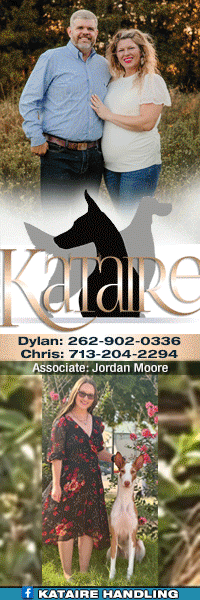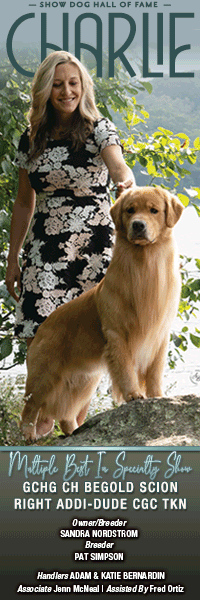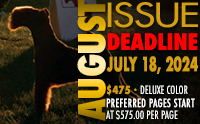Raising the Alarm on Designer Breeds
Click here to read the complete article
by Attila Márton
 There is now a wider diversity of varieties amongst new pets to choose from and take home. As the majority of people keep dogs with the intention of having a new social companion at home—not everyone lives, for instance, on a farm and needs the help of a herding dog—our expectations towards dogs has changed. We often want them to be funny and cute, fitting into our lifestyle and representing us to others. Dogs are definitely now more of a status symbol than an asset for everyday duties.
There is now a wider diversity of varieties amongst new pets to choose from and take home. As the majority of people keep dogs with the intention of having a new social companion at home—not everyone lives, for instance, on a farm and needs the help of a herding dog—our expectations towards dogs has changed. We often want them to be funny and cute, fitting into our lifestyle and representing us to others. Dogs are definitely now more of a status symbol than an asset for everyday duties.
What could be a better choice than a dog with a funny name and a cute appearance? It is refreshing to have additional varieties of these so-called designer breeds which are produced by crossing two different purebred dogs!
Moreover, these dogs are bred with the intention of getting rid of all the negative qualities of their ancestor breeds. Based on the concept that if we mix up the two different breeds, no genetically inherited diseases are going to be passed on, the positive characteristics of the personality of the breeds remain, and most of all, they are going to be hypoallergenic, so those who have any allergy issues but love dogs can finally have one—or as many as they want!
That is how the general public has been educated and thinks. This is the PR behind designer breeds. It’s absolute nonsense!
In the past, when one had a Rottweiler bitch in heat and the German Shepherd from the neighborhood jumped over the fence for some instinctual romance, the pups to be born were called ‘mutts’. Now in this new, human-created and consumer society-tailored aspect we use different, more trendy words like Rottsheppy, or Germanweiler, or whatever you can make up. Be creative! Actually, you are a genetic designer in action… a regular Dr. Franenmutt!
As a bonus, here comes the most fascinating news of the whole concept: you can charge a fortune for that! Especially when you take some extra cute pictures of the brand new breed, justifying that this currently emerging race within dogdom is absolutely too cute not to have one of them at home. This is the way these dogs are presented to the general public. Yet, as dogs are not a product, but living beings, the situation itself is far more complex.
You could easily say that such irony is born of envy. Perhaps I am jealous of all those new entrepreneurs who mate two different breeds and sell the pups for several thousand dollars each. It is a piece of cake to jump on the tidal wave that says keeping designer breeds is a cool trend and those who have started to operate this way have already built up a ‘brand’ with a socially acceptable and positive reputation.
The initial idea and reason behind mixing two different purebred dogs, as defined on Wikipedia is, ‘to avoid certain undesirable recessive traits that lead to genetic diseases that plague many purebred animals. To develop an animal that combines what are viewed as the best traits of two or more breeds.’
The very first crossbred dog starting this newhype was a Labradoodle back in the 1980s, ‘created’ by Wally Conron in Australia. His intention was to create a guide dog that did not shed its fur, for a blind woman whose husband was allergic to dogs. In the thorough article about designer breeds by Louise Eccles and Harry Mount, published in 2014 in the Daily Mail, Mr. Conron, the founding father of this new trend, declared that, ‘Instead of breeding out the problems, they’re breeding them in. For every perfect one, you’re going to find a lot of crazy ones. There are a lot of unhealthy and abandoned dogs out there. Not in my wildest dreams did I imagine all of this would happen.’
Despite his intention and regret, breeding dogs and inventing new creatures is still happening right here and now, and it seems that nothing can or will stop it.
The whole concept of creating new breeds this way focuses only on one main idea, and omits a very important thing, which is the ground zero of all the problems: genetics does not work this way. You do not need to be a scientist to know that it is pure nonsensical and wishful thinking to put two species together and expect only the positive aspects to pass through genetically and live on. However, people do believe this!
In his publication, Give a Dog a Bad Name, companion animal behavior counselor, Jim Stephens, MSC CABC, states the following facts regarding the basics of the ideology of mixing breeds like hybrids to invigorate and enhance their genetic inheritance:
“So is the concept of hybrid vigour true? In strict scientific terms the dog mixes are not hybrids since they are all dogs and hybrids are the result of different species breeding (donkey and horse to produce a mule). But are the offspring of two differing pedigree breeds likely to be “stronger” than the individual parents? The short answer is no.
Genetic inheritance means that the offspring can inherit good or bad from either or both parents; a trait carried by a recessive gene common to both parents but not affecting them, will show in a proportion of their offspring. To be absolutely sure that this doubling up of faults does not occur, then it would be necessary to screen both for possible genetic problems. Most pedigree breeders are aware of inheritable faults and test breeding stock to produce pups with the best chance of being healthy and to promote and improve the breed. However, the breeders of cross-pedigree dogs are unlikely to screen their breeding stock. As cross-bred dogs are not breeds, it is unlikely that Labradoodle breeders, for example, are trying to create a common recognisable type which are consistent in health, morphology and behaviour across generations and regions of the world.”
And there lies the truth. The concept of designer breed production is based on something that has never existed and never will. This foolish idea of ignoring scientific facts, combined with the ignorance that comes from self-delusion and self-deception, is likely to cause huge animal welfare problems as it leads to the creation of dogs with an absolutely unpredictable nature and physical make-up.
More and more reports emerge from vets, groomers, and trainers about the offspring of crossed purebred dogs with serious health issues, mental weaknesses, and behavior issues. It is more than obvious now, that for example, if you mate two Labradoodles, the pups will have no similarities nor a unique and determined characteristic featuring a definite breed. You can see the subsequent generations of Labradoodles (I mention that breed all the time as it is the most well-known and a really popular one) where you cannot recognize any sort of similarities between two pups of two different litters.
But the essence of breeds should be exactly like this. If you have one pug and you mate it with another one, you know for sure that many major attributes—both physically and mentally—remain the same. That is why and how we identify it as a breed. A breed as a term itself is not only about a name—or as many still think, about the existence of the pedigree—but about the general appearance and the temperament of each breed. You know exactly what the specifics are in a Bulldog, an Irish Wolfhound, and a Papillon. But you can forget this consistency with the mating and ‘developing’ of designer breeds.
Breeders are often under attack by claims that they breed dogs, claiming they are unhealthy animals. However, no one has ever proved that purebred dogs are less healthy than mutts. Moreover, in the case of real breeds, which have been around for centuries and which possess the well-known and stable attributes of their particular breed, health issues can be controlled better. We know exactly which breed tends to have genetically inherited diseases, for instance. In this case, breeders can check and consider at each mating how to reduce the risk of such illnesses in the forthcoming litters. These are based on scientific facts, and thanks to the development of DNA testing, disorders can be monitored better than ever as the scientific technology evolves.
That is not the case regarding crossbreeding and production of designer breeds. It is nothing more than a careless experiment to see what is going to happen. However, although the breeders of purebred dogs are the focus of attention from animal welfare groups and protection propaganda for supposedly producing unhealthy dogs, I have never yet seen any campaigns about this careless genetic experimenting we currently call ‘designer breeding’.
To make the whole process even more serious, if you are about to produce litters by crossing a Great Dane and a Chihuahua, you can register your litters as well. There are organizations to accommodate you. It makes it look more professional to hand over an official pedigree together with the pup. These people calling themselves breeders is also completely inappropriate. A breeder, excluding puppy farmers and those home breeders who mate the bitch at home with a buddy’s dog just so they can have a litter, is a professional person who takes responsibility. A breeder is aware of the general genetic terminology and has a good basic understanding of animal genetics, and a real breeder would never ever start to experiment like Dr. Moreau, creating something uncontrollable. Not to mention the fact that this sort of dilettante ‘breeding’ and playing with the genes of dogs can create absolutely unpredictable animals, there are other dangers in this procedure as well.
The general public’s knowledge about these newly-emerged breeds is that they were developed by selecting certain breeds which carry specific attributes and health conditions, to mix all the goodness together. However, they believe something that is absolutely false. Buyers of designer breeds are under the illusion that their new pet is going to be healthier than any other breeds, more intelligent and with fewer complications. A supernatural breed if you will. A superhero of the pet world. But the truth is somewhat different. There is a real danger of creating lots of mongrels this way. Not just because they are really expensive and people want to follow the fashion of keeping these designer dogs, but they are unable to see the whole picture. After all, it’s up to people regarding how they spend their money.
Whoever invented the term ‘designer breeds’ was really smart. These dogs are mutts, plain and simple. However, never before has someone paid thousands for a mutt. Whoever created this new style of dog production succeeded in building up a new brand around crossbred dogs with the promise of healthy and special dogs, with a really cute name and great appearance—perfect for showing off to the neighbors, while presenting something fresh and new after the boring, trivial and well-known breeds. It also makes the buyer seem like a hero by putting health and temperament first. We know this is false.
The characteristics of a breed plays a significant part in animal welfare and protection, even though we often do not really think about it that way. When someone gets a pup, it is vital that the dog fits into its new home. When the environment does not suit the behavior and temperament of the dog, this can cause serious problems and conflicts that can lead to the major animal welfare problem: stray dogs and crowded shelters.
What happens when someone realizes that the designer-bred dog, that cost them a fortune, will cost them the same amount again in treatments at the vet because of the serious illnesses it possesses? What happens when that unique and special cross-bred acclaimed as a superhero dog becomes a real pain in the neck due to its uncontrollable behavior and aggressive attitude?
The answer is also here. The RSPCA (Royal Society for the Prevention of Cruelty To Animals) UK issued its national press release on February 2, 2016 about this matter, stating the following: ‘While the individual numbers seem low, the figures do reveal a concerning trend: while numbers of traditionally common rescue dogs drop (such as Staffies, lurchers and Jack Russell terriers), the number of ‘designer’ breeds and crossbreeds are climbing. As the popularity of ‘designer’ crossbreeds – such as Labradoodles (Labrador cross poodle), Puggles (Pug cross beagle), and Cavachons (Cavalier King Charles Spaniel cross Bichon Frise) – booms, so do the numbers coming into our centres.’
That is what professionals who work with animals every day have been warning us about. These sort of crossbred dogs are suffering from serious skin allergies, other health issues, and unpredictable temperaments. Due to this, these newly-produced so-called breeds are gaining a higher and higher presence in shelters.
All dogs are cute and deserve a good life. Even if it is a purebred dog, a crossbred dog or a crossbred dog of purebred parents and renamed a ‘designer’ breed.
With this careless and deliberate genetic experimentation it is proven again that humanity likes to play God, but forgets and refuses to see or even consider the side-effects and real consequences of their actions.
The existence of, and moreover the positive promotion of this sort of dog production has been a problem. However, I cannot really see any organizations actively campaigning against this trend. This is a situation affecting the life of breeders, animal welfare organizations, vets, shelters and kennel clubs as well. Everyone is involved and public awareness should be raised about the topic, explaining that these new breeds are not really the ones the brand is about. The promotion of both buying and starting to breed these dogs should be stopped. It will not happen automatically, so it would just be good if those who come into contact with this issue on a daily basis could start to wake up and raise their voices really loud. I myself turned the alarm on.
Short URL: http://caninechronicle.com/?p=99795
Comments are closed











